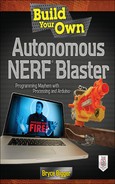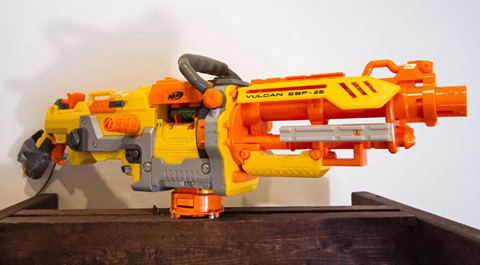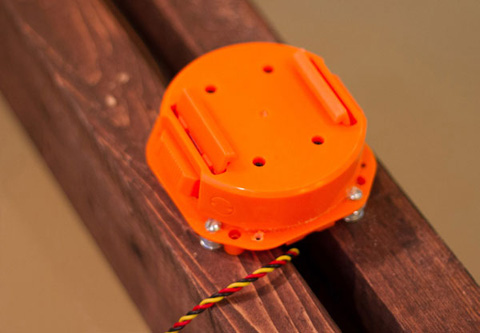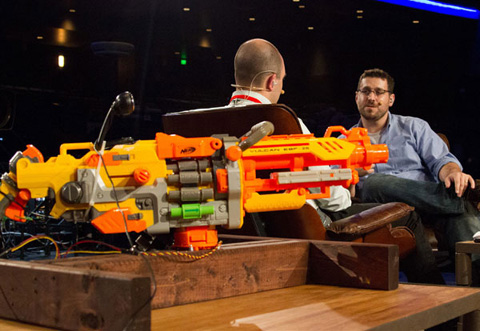2
Building a NERF Niche
In the spring of 2010, the organizers of Refresh Columbia (my local web design/development user group) asked for presenters. Foolishly, I volunteered. So that meant I had just a few weeks to piece something together for an upcoming meeting.
There were a few self-imposed objectives. I wanted to present something different and unusual. Keeping both designers and developers interested is challenging because developers are into the code and designers want pixel perfection. I left the proverbial drawing board after seeing an automated paintball blaster setup. Why not a NERF blaster, I thought. They’re a staple in office warfare. They’re fun. They have ambush potential. The kicker was the nerd catnip level. Would they love it? Well, you’re reading this, aren’t you?
That’s how the Sentinel Project was born. Next came plans and the real work of bringing the thing to life, fast. Here’s what went down.
The Sentinel Project
First order of business? Find the right NERF blaster. Back then, it was the Vulcan (Figure 2-1).
FIGURE 2-1 The original NERF Vulcan blaster used for demos and displayed at AdobeMAX 2010. Currently retired from active duty.
This was the one blaster that had belt-fed ammo (Rambo!) and automatic fire, which made it ideal for the project over other options. It also had a large footprint with a generous area to support our after market attachments.
Next came a homemade wooden base to hold the “Franken-Vulcan.” The base also accommodated a servo motor (to rotate the blaster; Figure 2-2) and an Arduino board (to make the motor move and pull the trigger).
After strapping on a webcam for optics (Figure 2-3), I brought it all to life with Adobe Flash compiled to an Adobe AIR application (managing video processing and a user interface) on a laptop. The Sentinel turned out to be a big hit at the meeting, and I did, in fact, savor 15 seconds of local fame.
It was surprising when that 15 seconds of glory grew into 15 minutes of national fame. Shortly after the Refresh Columbia meeting, videos were posted to YouTube. Not long after, a direct message dinged in via Twitter from Adobe. Yeah, the real Adobe. It turns out they’d seen the blaster and wanted it out west for part of the keynote presentation at the AdobeMAX conference in October 2010 (Figure 2-4). Watch it—vimeo.com/16277816. After the conference wrapped up and the wheels were back on the ground on the East Coast, the source code was placed on Google Code for tinkerers one and all.
Then, just like that, I got one more jaw-dropping connection, and the Sentinel took yet another giant leap for robot-kind. MailChimp, the head monkey in e-mail newsletters, wanted a Sentinel. Sorta.
What MailChimp really wanted was a distant cousin of the prototype. They needed an amped-up version of the Sentinel—a dual-cannon remote-controlled installation—that the tech provider’s customers could access to pelt MailChimp customer reps. To the chagrin of the company’s employees, the “roided-up” Sentinel was delivered on time in June 2011. You can watch the mayhem unfold with this video—vimeo.com/25470064.
Just like that, the streak of NERF glory was about to sunset. Then the phone rang again. It turns out that there’s a whole audience of people who want to build stuff like this. So just like that, tinkering turned into a book deal. So tinkering—again—is not at all a waste of time. No matter what your dad says.
I’ll bet that you think the Sentinel project was a piece of cake, right? I mean, how hard could it be? I did it, and I am no rocket scientist. Not so fast. Yeah, the prototype worked, but it definitely had a few flaws. Here’s the skinny on why what you’re going to build is way better than the original prototype.
The Design
The blaster was never made for any durable duty. It was supposed to be like a stuffed deer head. You know, more decoration than day-in, day-out use. As it turned out, the whole shebang—even with the heavy base—was shaky and flimsy. The placement of the battery pod in the NERF blaster’s original design was troublesome. In fact, it had to be removed, or the weight of the blaster would warp the swivel stand. If that happened, the stand could no longer hold the blaster in its teeth. Not good. And then there were the wires. They made the whole project look a little cluttery. On the other hand, it shot things like a boss.
The Blaster
Another trouble spot—the Vulcan. You won’t find the Vulcan at a big-box retailer. The Vulcan model is now in the NERF history book. You might be able to pick one up on eBay, but it’s no longer in production. So my design, which centered around this one blaster in particular, had to be retooled to work on other models.
The Base
This part of the design is the real Achilles’ heel of the original Sentinel. The large wooden base had to be clunky and heavy to support the blaster in the required position. The base was part of the original design, so it was only meant for the Vulcan blaster. It was too custom. Oh, and try to pick it up and take it anywhere? Fuhgeddaboudit.
The Code
Back in the old days (2010), we used Flash because it was still in vogue. Then He from Apple Who Shall Not Be Named bad-mouthed it. Next thing you know, you can’t say the word Flash without coming under scrutiny. Today we have better stuff, and the better stuff is free. Flash IDE will set you back about $600. We’ll be using Processing, which is the right price for any tinkerer—free. Processing and its vast open-source library provide easy access to great code for computer vision. And best of all, Processing is easy to learn for anyone—even a novice.
All in all, the prototype was too custom, too flimsy. It was fine for a demo but not to be repeated in craft model production. I simply had an idea and tinkered it to life. This book is brought to you by the trials and tribulations of the Sentinel prototype and MailChimp projects. So, unless you want to build a Sentinel of your own, let’s get started on its better, faster, stronger, easier big brother, your very own NERF blaster.
Now, if you still really want to build the original because you know Flash and/or have all the requisite parts lying around, I’m not going to stop you. Check out Appendix B.




